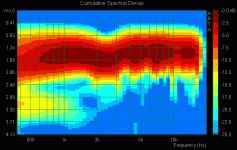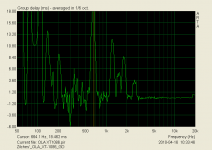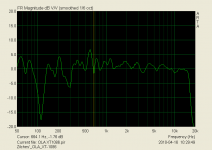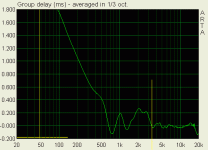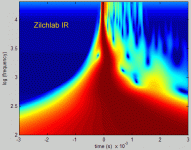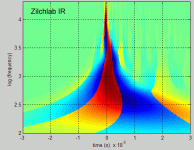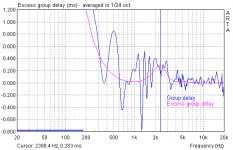Hello Elias,
There is surely one thing that can be improved it is the crossover. (This is not a Le Cléac'h crossover as we can see by the noticeable delay around 2500Hz on the CSD here attached).
Best ergards from Paris, France
Jean-Michel Le Cléac'h
There is surely one thing that can be improved it is the crossover. (This is not a Le Cléac'h crossover as we can see by the noticeable delay around 2500Hz on the CSD here attached).
Best ergards from Paris, France
Jean-Michel Le Cléac'h
Hello,
Here's ZilchLab's impulse response file converted to WAV. I assumed sampling freq of 48kHz.
- Elias
Attachments
Hi,
I don't understand your description what you would like to do? Import what from where to where? 😀
- Elias
...importing ARTA wav file into an Octave variable.
Basically ARTA wav file is a plain text file - BUT -
There are headers in ARTA wav file that have to be removed
Those headers in ARTA wav file spoil the simple "load" command of Octave
I haven't found appropriate file handling / manipulation commands in Octave to manage those data (st)ripping from ARTA wav file
😉
Michael
Last edited:
...as we can see by the noticeable delay around 2500Hz...
I sure see the delay shift. But how bad is it really? Looks like a shift of about 2.5" to me, or 64mm. Could be better, but not that bad. Is that the right distance?
?? WAV file is a binary file, not a text.
Maybe post one file and let's see 😀
- Elias
Maybe post one file and let's see 😀
- Elias
...importing ARTA wav file into an Octave variable.
Basically ARTA wav file is a plain text file - BUT -
There are headers in ARTA wav file that have to be removed
Those headers in ARTA wav file spoil the simple "load" command of Octave
I haven't found appropriate file handling / manipulation commands in Octave to manage those data (st)ripping from ARTA wav file
😉
Michael
Hi Elias,
I don't know why the earlier sim configurations have significantly less points. Could you see if 17ms or so impulse works as well?
Hello,
Are you going to tell us what is your device? 🙂
- Elias
These are wave guides that I've been trying to design. Basically exploring the possibility of optimizing directivity, loading, and stored energy. Most data have been posted in the Geddess thread because that's where I was first inspired to do so. It's probably been two years now since the first elliptical wave guide that was build. The wave guides are driven by a concaved dome driver. Incidentally, the curves are getting a bit closer to the OS wave guide curve, but still not quite the OS as Earl originally posted. The "back 1" is the previous version, and the "back 2" is the design before back one. The one you already did a "noodle" plot on is the latest one. All impulse data are from simulation using AxiDriver and VACs viewer for converting and view the results.Hello,
Are you going to tell us what is your device? 🙂
- Elias
Last edited:
?? WAV file is a binary file, not a text.
Maybe post one file and let's see 😀
- Elias
Sure, sorry !
Octave "wavread" command already works fine for importing 16bit and 32bit *.wav files !
#########
Its the ATRA *.txt files I have troubles with...
Here is an example:
http://www.kinotechnik.edis.at/pages/diyaudio/GD_HighPass/ARTA_try.txt
Basically we only would have to remove the first 4 header lines - but I didn't find the right commands in Octave to do so (I think Matlab has more extended file manipulation skills).
Sure - I could do *externally* with any editor - but I'd like to integrate that format of ARTA in my IR file loading script - so I want to do it in Octave directly...
"load ("-ascii", (ir_file_name));" isn't the way to go
🙁
Michael
Ummmm,
- Am I being unfare to Zilch by posting these pics derived from the following parameters ?
- I imported the OLA WAVE file into ARTA ( that Elias had transposed ) / then went for a HiRez look-see and got the following .
- ( 91 ms Gate / Full Window / 256K FFT )
- Am I looking at a whole lot of diffraction effects here ?


- Zilches' Original FR Look :

<> EarlK
- Am I being unfare to Zilch by posting these pics derived from the following parameters ?
- I imported the OLA WAVE file into ARTA ( that Elias had transposed ) / then went for a HiRez look-see and got the following .
- ( 91 ms Gate / Full Window / 256K FFT )
- Am I looking at a whole lot of diffraction effects here ?
- Zilches' Original FR Look :
<> EarlK
Attachments
Hello Panomaniac,
I'll do a parallel with horns. I used to try different cut-off frequency for the high pass crossover for many Le Cléac'h horns having different acoustical cut-off ferquency. (The summation LP + HP of the used crossover has low phase distortion).
What I noticed is that the sound was improved when the cut-off frequency of the HP crossover was such that the corresponding group delay of the horn was lesser than 100mm.
So most probably the phase distorsion responsible of those 65 mm delay at 2500Hz will not be much noticeable but reducing that phase distortion will improve the sound... (at least for trained ears...).
See a comparison of the quasiwavelet graphs of a le Cléac'h crossover (left) and of a classic Butterworth 3rd order (right) at:
http://www.diyaudio.com/forums/atta...audio-measurements-what-how-wavelet_phase.gif
Best regards from Paris
Jean-Michel Le Cléac'h
I'll do a parallel with horns. I used to try different cut-off frequency for the high pass crossover for many Le Cléac'h horns having different acoustical cut-off ferquency. (The summation LP + HP of the used crossover has low phase distortion).
What I noticed is that the sound was improved when the cut-off frequency of the HP crossover was such that the corresponding group delay of the horn was lesser than 100mm.
So most probably the phase distorsion responsible of those 65 mm delay at 2500Hz will not be much noticeable but reducing that phase distortion will improve the sound... (at least for trained ears...).
See a comparison of the quasiwavelet graphs of a le Cléac'h crossover (left) and of a classic Butterworth 3rd order (right) at:
http://www.diyaudio.com/forums/atta...audio-measurements-what-how-wavelet_phase.gif
Best regards from Paris
Jean-Michel Le Cléac'h
I sure see the delay shift. But how bad is it really? Looks like a shift of about 2.5" to me, or 64mm. Could be better, but not that bad. Is that the right distance?
Room reflections?Ummmm,
- Am I being unfare to Zilch by posting these pics derived from the following parameters ?
- I imported the OLA WAVE file into ARTA ( that Elias had transposed ) / then went for a HiRez look-see and got the following .
- ( 91 ms Gate / Full Window / 256K FFT )
- Am I looking at a whole lot of diffraction effects here ?
...
<> EarlK
Hello Earl,
here is attached what I consider a better group delay curve for Zilchlab IR. (I think you didn't use any marker before the first main reflection arrival.) But your's and mine lead to the same intrepretation.
We can see that above 3 kHz the group delay curve is very flat. (so it is "less" flat below 3kHz)
Best regards from Paris
Jean-Michel Le Cléac'h
here is attached what I consider a better group delay curve for Zilchlab IR. (I think you didn't use any marker before the first main reflection arrival.) But your's and mine lead to the same intrepretation.
We can see that above 3 kHz the group delay curve is very flat. (so it is "less" flat below 3kHz)
Best regards from Paris
Jean-Michel Le Cléac'h

<> EarlK
Attachments
Last edited:
J-M said:here is attached what I consider a better group delay curve for Zilchlab IR. (I think you didn't use any marker before the first main reflection arrival.) But your's and mine lead to the same intrepretation.
Thank-You for that !
<> EarlK
Wouldn't it be much easier to remove header manually?
Yes indeed - but I am on packing a modular code, that is usable for anybody that wants to get into it.
One of the modules is the file import module - up to now it support imüport of wav file (16 bit and 32 bit) and plain text, ether one column or two column formatted.
So adding CLIO export file and ARATA txt export would be "nice to have"...
Normalization feature is ready and skeleton noodles and wavelet analysis are on the stove.
🙂
Michael
Hi,
How to transfer impulse response file from ARTA to OCTAVE
This Octave script read ARTA .txt file, skips the header, and reads the data into Octave matrix.
One plot is generated for your convenience.
### Read ARTA txt file into Octave matrix
filename = 'D:/temppi/ARTA_try.txt'
fid = fopen (filename);
fgetl (fid)
fgetl (fid)
fgetl (fid)
fgetl (fid)
data = zeros (2^18, 2);
i = 1;
while (! feof (fid) )
data (i++, 🙂 = str2num (fgetl (fid));
endwhile
fclose (fid);
data = data(1 : i - 1, 🙂;
figure (1)
plot (data🙂, 1), data🙂, 2));
- Elias
How to transfer impulse response file from ARTA to OCTAVE
This Octave script read ARTA .txt file, skips the header, and reads the data into Octave matrix.
One plot is generated for your convenience.
### Read ARTA txt file into Octave matrix
filename = 'D:/temppi/ARTA_try.txt'
fid = fopen (filename);
fgetl (fid)
fgetl (fid)
fgetl (fid)
fgetl (fid)
data = zeros (2^18, 2);
i = 1;
while (! feof (fid) )
data (i++, 🙂 = str2num (fgetl (fid));
endwhile
fclose (fid);
data = data(1 : i - 1, 🙂;
figure (1)
plot (data🙂, 1), data🙂, 2));
- Elias
Last edited:
Hello,
You'll find here attached quasiwavelets graph (amplitude then hybrid amplitude x sign of phase) I obtained using my Matlab routine on Zilchlab IR.
(eventually compare with the quasiwavelets obtained for 2 crossovers I previously gave)
Best regards from Paris, France
Jean-Michel Le Cléac'h
You'll find here attached quasiwavelets graph (amplitude then hybrid amplitude x sign of phase) I obtained using my Matlab routine on Zilchlab IR.
(eventually compare with the quasiwavelets obtained for 2 crossovers I previously gave)
Best regards from Paris, France
Jean-Michel Le Cléac'h
Attachments
Last edited:
Yes, correct.Here's ZilchLab's impulse response file converted to WAV. I assumed sampling freq of 48kHz.
Yes, the crossover occurs acoustically at ~1.425 kHz. The HF is connected inverse polarity which, in combination with phase delay in the filters, compensates for the offset of the acoustic centers, the compression driver being approximately that distance behind the woofer. I believe this measurement to have been taken on the forward axis as located vertically at the maximal-depth reverse-polarity notch.I sure see the delay shift. But how bad is it really? Looks like a shift of about 2.5" to me, or 64mm. Could be better, but not that bad. Is that the right distance?
The CLIO AES white paper illustrates a similar situation; the delay is required to bring the woofer and waveguide into phase alignment in the crossover region. Alternatively, the drivers could be run in the same polarity with the woofer delayed to better result, but as you suggest, this design is "not that bad." It was developed using Jeff Bagby's PCD (Passive Crossover Designer) beginning here:
Flex Your PCD Mettle: - Page 10 - Techtalk at Parts-Express.com
This iteration is detailed at Post #199; note the phase interference between 2.0 kHz and 3 kHz, and also the presence of a notch filter just above there, to flatten the response. The schematic is not yet posted, but will be soon.
SO, do we place 18-Sound XT1086 into the "Honker" cell here based upon these analyses? 😀
Last edited:
Here is the same thing plotted at 1/24 octave smoothing rather than 1/3 octave. The group delay curve is quite noisy but plotting it as excess group delay shows what is going on better IMO, removing group delay caused strictly by the frequency response.Hello Earl,
here is attached what I consider a better group delay curve for Zilchlab IR. (I think you didn't use any marker before the first main reflection arrival.) But your's and mine lead to the same intrepretation.
We can see that above 3 kHz the group delay curve is very flat. (so it is "less" flat below 3kHz)
Best regards from Paris
Jean-Michel Le Cléac'h
Attachments
- Status
- Not open for further replies.
- Home
- Loudspeakers
- Multi-Way
- Horn Honk $$ WANTED $$
